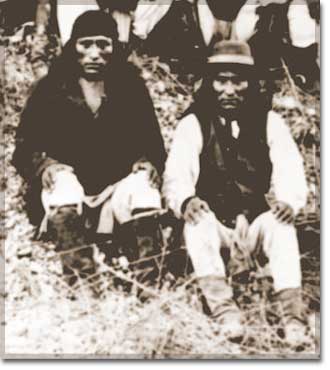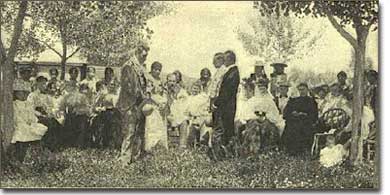40d. Life on the Reservations

After being forced off their native lands, many American Indians found life to be most difficult. Beginning in the first half of the 19th century, federal policy dictated that certain tribes be confined to fixed land plots to continue their traditional ways of life.
The problems with this approach were manifold. Besides the moral issue of depriving a people of life on their historic land, many economic issues plagued the reservation. Nomadic tribes lost their entire means of subsistence by being constricted to a defined area. Farmers found themselves with land unsuitable for agriculture. Many lacked the know-how to implement complex irrigation systems. Hostile tribes were often forced into the same proximity. The results were disastrous.
The Dawes Act
Faced with disease, alcoholism, and despair on the reservations, federal officials changed directions with the Dawes Severalty Act of 1887. Each Native American family was offered 160 acres of tribal land to own outright. Although the land could not be sold for 25 years, these new land owners could farm it for profit like other farmers in the West.

Congress hoped that this system would end the dependency of the tribes on the federal government, enable Indians to become individually prosperous, and assimilate the Indians into mainstream American life. After 25 years, participants would become American citizens.
The Dawes Act was widely resisted. Tribal leaders foretold the end of their ancient folkways and a further loss of communal land. When individuals did attempt this new way of life, they were often unsuccessful. Farming the West takes considerable expertise. Lacking this knowledge, many were still dependent upon the government for assistance.
Many 19th century Americans saw the Dawes Act as a way to "civilize" the Native Americans. Visiting missionaries attempted to convert the Indians to Christianity, although they found few new believers.
"Americanizing" the Indians
Land not allotted to individual landholders was sold to railroad companies and settlers from the East. The proceeds were used to set up schools to teach the reading and writing of English. Native American children were required to attend the established reservation school. Failure to attend would result in a visit by a truant officer who could enter the home accompanied by police to search for the absent student. Some parents felt resistance to "white man education" was a matter of honor.
In addition to disregarding tribal languages and religions, schools often forced the pupils to dress like eastern Americans. They were given shorter haircuts. Even the core of individual identity — one's name — was changed to "Americanize" the children. These practices often led to further tribal divisions. Each tribe had those who were friendly to American "assistance" and those who were hostile. Friends were turned into enemies.
The Dawes Act was an unmitigated disaster for tribal units. In 1900, land held by Native American tribes was half that of 1880. Land holdings continued to dwindle in the early 20th century. When the Dawes Act was repealed in 1934, alcoholism, poverty, illiteracy, and suicide rates were higher for Native Americans than any other ethnic group in the United States. As America grew to the status of a world power, the first Americans were reduced to hopelessness.






